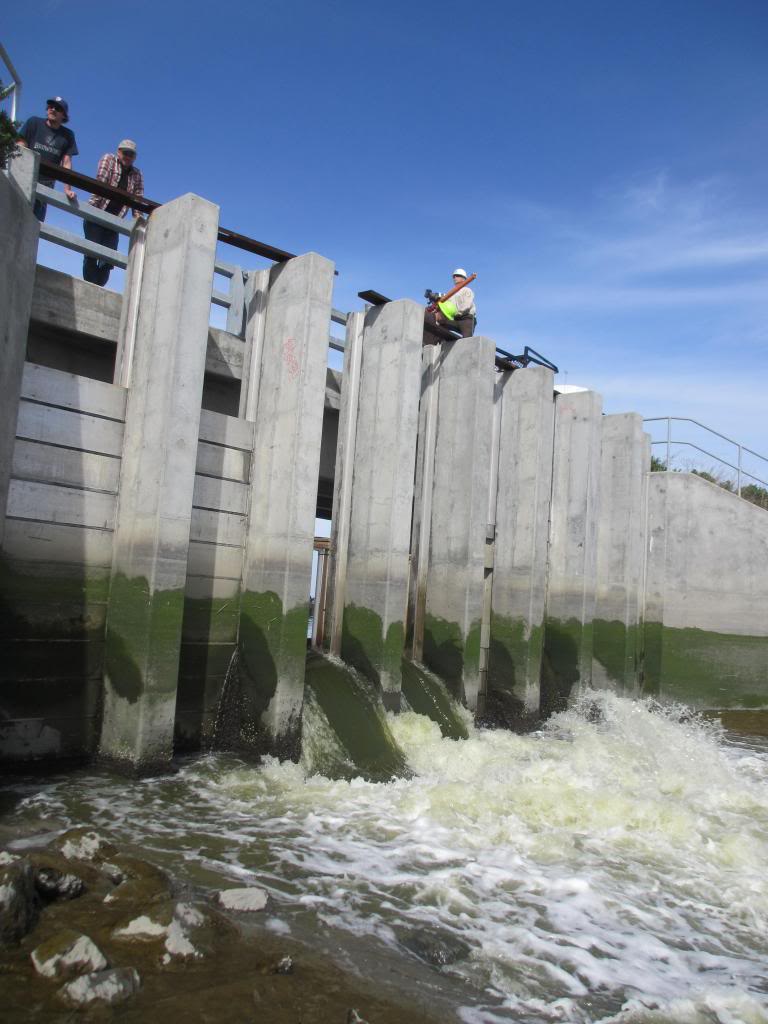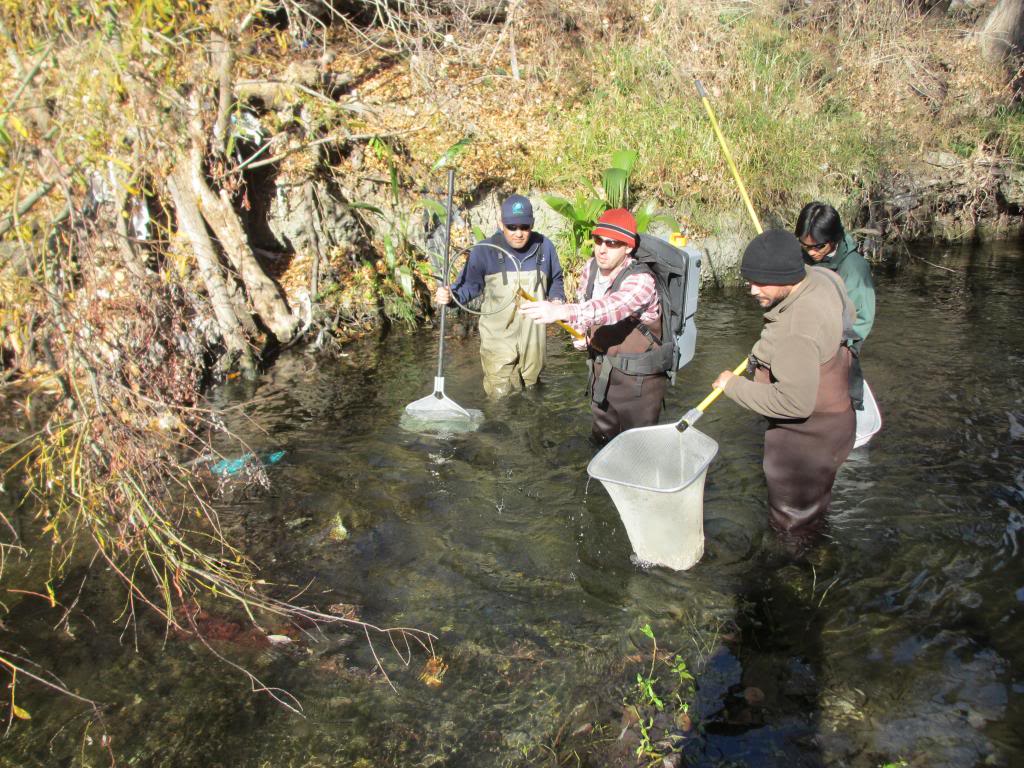by Joe Eaton
The restoration of the South Bay salt ponds to tidal wetland has, from the very beginning, been an exercise in adaptive management: take an action; monitor the results; make any indicated fixes; repeat. There’s no better example than Pond A8, where the Guadalupe River enters San Francisco Bay via Alviso Slough. Restoration planners were worried that connecting the former salt evaporation pond with the Bay could introduce long-dormant mercury to the wider ecosystem, and initial studies of levels in water bird eggs and fish reinforced that concern. A set of adjustable gates between the pond and the river allows seasonal closure of the pond and the ability to control the flow. But that raised a new question: would the river’s steelhead run get sidetracked into potentially dangerous waters as they move past the gate and out to the Bay? A high-tech approach to tracking the movement of outbound juvenile steelhead has provided preliminary answers, along with better understanding of a little-studied fish population. Meanwhile, continued monitoring of mercury levels suggests opening A8 may not be worsening contamination.

Mercury is one of the Bay’s legacy contaminants. As the US Geological Survey’s Laura Valoppi, lead scientist for the restoration project, explains, it’s been washing down from the New Almaden district in the Santa Clara foothills since mining began in 1845:“The more rainfall, the more mercury it mobilizes.” Up to 90 percent of the Guadalupe’s mercury load is mining derived– its watershed once contained one of the largest mercury mines in the Northern Hemisphere. Lester McKee of the San Francisco Estuary Institute’s Clean Water Program calls the river “the number one mercury-pollution hot spot in the Bay Area.” He’s measured higher concentrations of mercury particles in water and sediment, and higher total concentrations in water, in the Guadalupe than any other Bay tributary.
When it reaches the sediments of the former marshland that is now PondA8, mercury can undergo a sinister alchemy called methylation. “Especially in the spring, water temperatures get warm and create good conditions for methylation,” says restoration project manager John Bourgeois. Algae proliferate, then die off, creating a feast for bacteria. The bacteria create methyl mercury, a more toxic form of the element that is much more easily absorbed into aquatic foodwebs, as a byproduct of their metabolism. “If the pond was open to the Bay all year round, flow conditions would cool temperatures down, increase circulation, and minimize the production of algae,” Valoppi continues. But that could expose the Bay to a methylmercury backlog. “We want to restore full tidal action, but not put the Estuary at risk by increasing the input of mercury,” Bourgeois says.
That’s why they built the Notch: a40-foot concrete structure with eight movable gates to let managers govern the movement of water in and out ofA8. The gates are kept closed from December 1 through May 31 every year, out of concern that out-migrating juvenile steelhead might swim into the pond and be unable to navigate back out to the Bay. Managers are also concerned the steelhead might be unable to find refuge from predators in the shallow pond or suffer from adverse water quality.

The seasonal closure also seemed prudent in view of the elevated mercury levels that had been recorded in fish from Guadalupe and Alviso slough sand in the eggs of fish-eating Forster’ sterns that nested locally. Concerns that this could be an ongoing problem were allayed by new data: tern eggs analyzed last year showed a 60 percent decrease in mercury levels from 2011. (Monitoring was interrupted in 2012 for lack of funding.) “Also, in 2013 there was no increase in mercury in fish in the sloughs that we could attribute to A8,”says Valoppi.
Scientists now wonder if the previous increase was a one-off event due to mercury-loaded sediment stirred up by construction activity. “That’s our hope,” says Valoppi. “Even though it was shut six months of the year, there were enough flows that the mercury source decreased. Mercury levels in the terns are still really high, and that’s a concern.” But the pattern suggests this piece of the restoration project is on the right track: “We’re trying to create habitat, not make things worse.”

Mercury researchers encouraged the project to open the Notch earlier or keep it open year round. But what about the steelhead? “We turned it into an experiment,” Bourgeois recalls, underlining the ongoing adaptive management approach of his project. The National Marine Fisheries Service approved a test of alternatives, conditional on a study of steelhead movement. That brought in UC Davis fish biologist Jim Hobbs, who was already monitoring how fish responded to the restoration process. This year, the Notch was opened in March while the steelhead were moving out.
In an urban stream like the Guadalupe, mercury is not the only challenge for steelhead. Fed by creeks in the Santa Cruz Mountains, it flows through downtown San Jose, not far from the Sharks’ arena. A historic coho salmon run is long gone. Steelhead persist, but encounter urban challenges: homeless people turn shopping carts into improvised weirs, trapping adults as they move upstream to spawn. The last thing these anadromous trout need is a death trap at the mouth of the Bay.
Hobbs surveyed the river and its tributaries, selecting five monitoring stations on feeder creeks, along the Guadalupe mainstem, and at the Notch. Steelhead smolts were captured upstream, equipped with passive integrated transponder (PIT) tags — “the same technology used in microchipping pets,” he explains — and released at the capture site. Of 71 tagged fish, only seven were detected by the monitors. “One of the seven went into A8and right back out again,” he adds. Nota huge data set, but Valoppi and Hobbs hope funding will allow a repeat next year — and an extension of mercury monitoring. “As a bonus, we’re getting really good data on a population that’s not well studied,” Bourgeois says. JE
For more great photos of SF Bay fish research click here
CONTACT
John Bourgeois, [email protected]
Laura Valoppi, [email protected]
Jim Hobbs, [email protected]
Lester McKee, [email protected]
NEXT ARTICLE: Hamilton Done, But More to Do